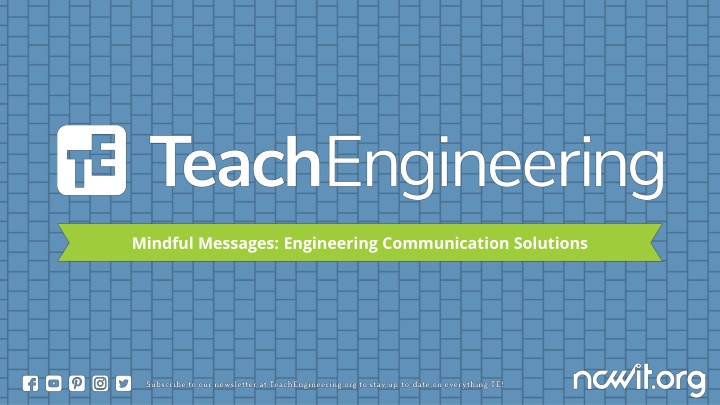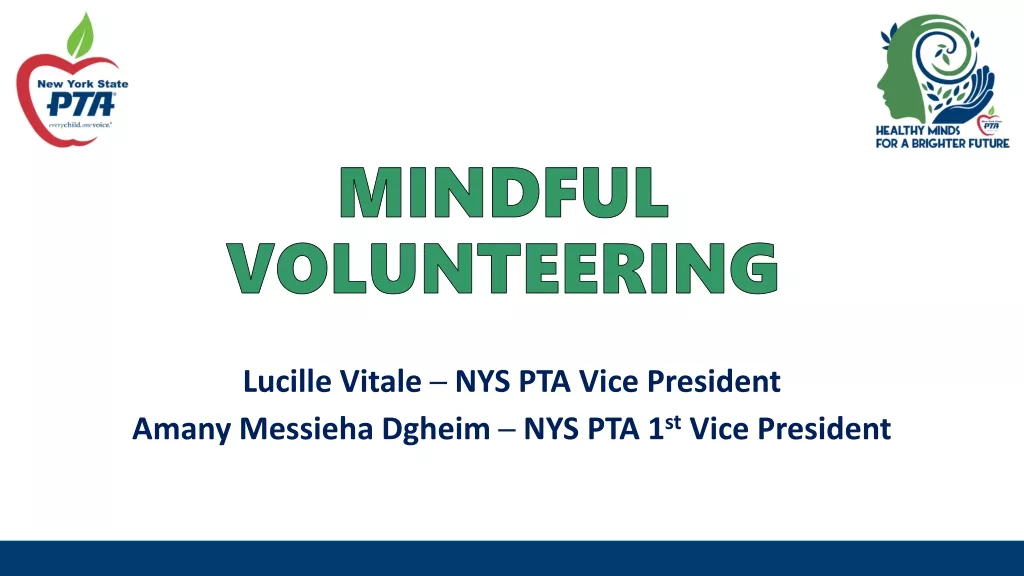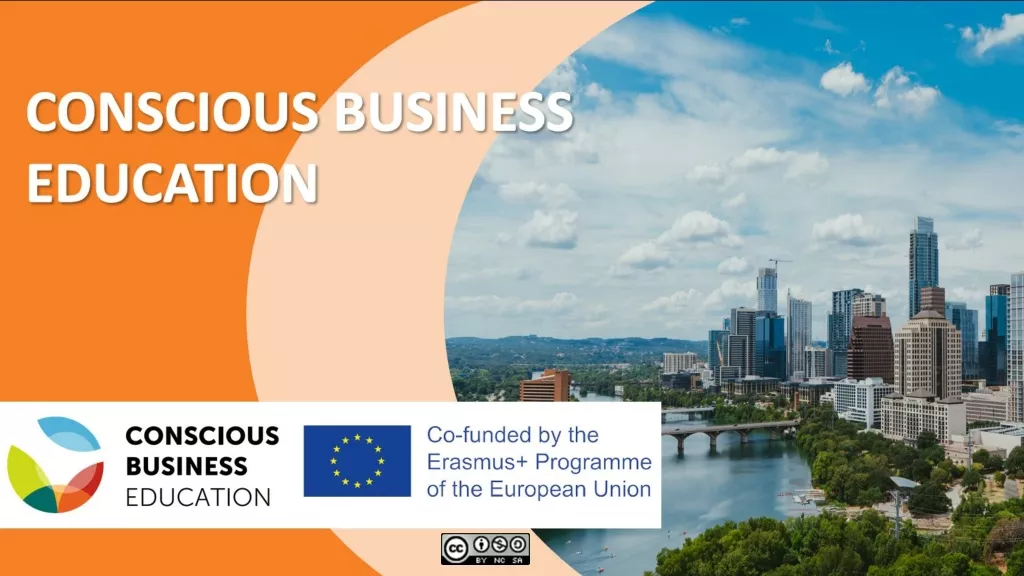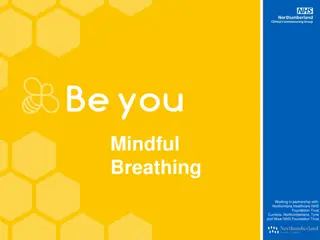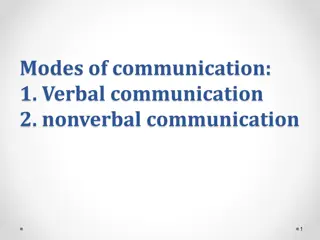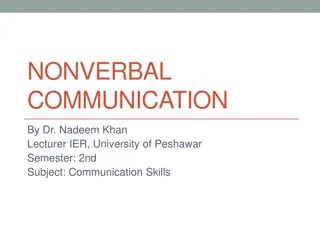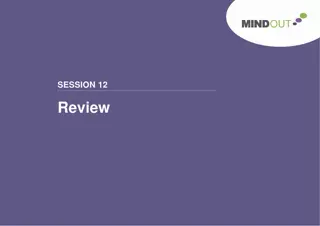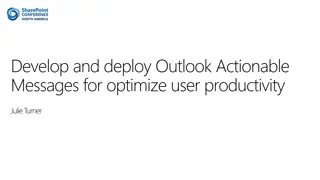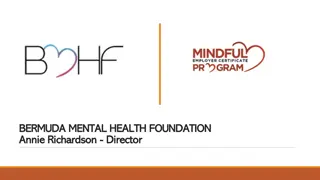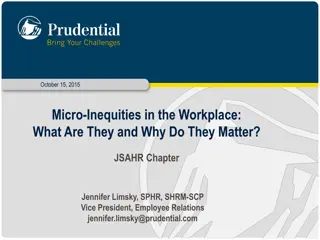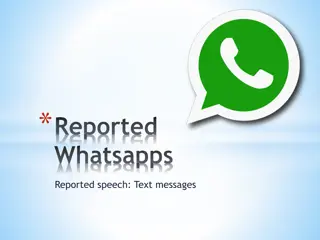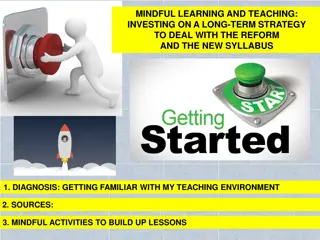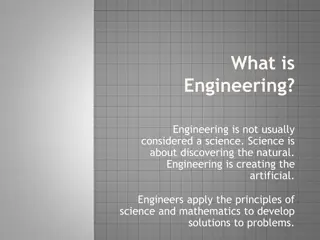Engineering Communication Solutions with Mindful Messages
Discover how communication plays a crucial role in problem-solving. Explore the impact of the brain on communication and learn how to generate and compare solutions effectively. Enhance your understanding of engineering principles and academic vocabulary related to communication. Engage in hands-on activities to improve prototypes and create communication tools using micro:bit technology. Dive into pre-activity assessments and explore challenges faced by individuals with hearing impairments and language barriers. Gain insights into the importance of communication in overcoming obstacles and fostering innovation.
Download Presentation

Please find below an Image/Link to download the presentation.
The content on the website is provided AS IS for your information and personal use only. It may not be sold, licensed, or shared on other websites without obtaining consent from the author.If you encounter any issues during the download, it is possible that the publisher has removed the file from their server.
You are allowed to download the files provided on this website for personal or commercial use, subject to the condition that they are used lawfully. All files are the property of their respective owners.
The content on the website is provided AS IS for your information and personal use only. It may not be sold, licensed, or shared on other websites without obtaining consent from the author.
E N D
Presentation Transcript
EDUCATIONAL STANDARDS 3-5-ETS1-1: Define a simple design problem reflecting a need or a want that includes specified criteria for success and constraints on materials, time, or cost. 3-5-ETS1-2: Generate and compare multiple possible solutions to a problem based on how well each is likely to meet the criteria and constraints of the problem. 3-5-ETS1-3: Plan and carry out fair tests in which variables are controlled and failure points are considered to identify aspects of a model or prototype that can be improved. 3-5.OA-Operations and Algebraic Thinking
LEARNING OBJECTIVES Understand the role of the brain in communication. Define a design problem related to communication. Generate and compare multiple solutions. Plan and conduct fair tests to improve a prototype. Use a micro:bit to create a communication tool.
ACADEMIC VOCABULARY communicate To send or receive a message. sound Noise caused by an object vibrating. light Allows us to see objects in the dark. message Information that is sent or given to someone. computer programming The process of giving a computer instructions in a language it can understand; also called coding. transmit To send from one place to another. microchip The brains of electronic devices; they send and receive patterns that help our electronics work. engineer Someone who designs, builds, and tests things to solve problems.
ACADEMIC VOCABULARY engineering Using science and math to creatively solve problems. design A sketch, model, or plan for something. problem A challenge that needs a solution. solve To find a solution to a challenge or problem. improve To make something better. test To check to see if something is working.
PRE-ACTIVITY ASSESSMENT What happens in our brain when we talk or write? Why is communication important for solving problems? Name a tool that helps people with hearing loss communicate.
INTRODUCTION What happens in our brain when we talk or listen? What happens in our brains when we read or write? Why do you think communication is essential for solving problems? Can you think of any examples?
INTRODUCTION What challenges do people with hearing impairments face? How do they overcome them? What challenges do people with language barriers face? How do they overcome them? What challenges do people have in a noisy environment? What do they do in that situation?
COMMUNICATION CHALLENGES AND POSSIBLE SOLUTIONS Communication Challenge Possible Solution
QUESTIONS ABOUT HOW THE BRAIN HELPS US COMMUNICATE How does sign language work? What s the best way to learn a new language? How do hearing aids work? Other questions:
OPTIONAL VIDEOS Generation Genius (Subscription required) o What is Engineering? - https://www.generationgenius.com/videolessons/what-is- engineering-video-for-kids o Engineering Design Process - https://www.generationgenius.com/videolessons/engineering-design-process-video-for- kids o Brain Processing of Senses - https://www.generationgenius.com/videolessons/senses- video-for-kids o Communication Over Distances- https://www.generationgenius.com/videolessons/communication-over-distances-video- for-kids o Information Transfer - https://www.generationgenius.com/videolessons/information- transfer-video-for-kids
OPTIONAL VIDEOS BrainPop (Subscription required) o Engineering and Design Process (Lower level) - https://jr.brainpop.com/topic/engineering-and-design-process o Listening and Speaking - https://jr.brainpop.com/topic/listening- and-speaking o Engineering Design Process (Higher level) - https://www.brainpop.com/topic/engineering-design-process o Computer Programming - https://www.brainpop.com/topic/computer-programming
OPTIONAL VIDEOS YouTube o What s an Engineer? Crash Course Kids #12.1 - https://www.youtube.com/watch?v=owHF9iLyxic&list=PLhz12vamHOnZ4ZDC0dS6C9HRN5Qrm0jHO&in dex=1 The Engineering Process: Crash Course Kids #12.2 - https://www.youtube.com/watch?v=fxJWin195kU Defining a Problem: Crash Course Kids #18.1 - https://www.youtube.com/watch?v=OyTEfLaRn98&list=PLhz12vamHOnZ4ZDC0dS6C9HRN5Qrm0jHO&i ndex=3 Defining Success: Crash Course Kids #18.2 - https://www.youtube.com/watch?v=XyFUqFQfl30&list=PLhz12vamHOnZ4ZDC0dS6C9HRN5Qrm0jHO&in dex=4 Got Some Solutions?: Crash Course Kids #26.1 - https://www.youtube.com/watch?v=WGESd7O4_Uk&list=PLhz12vamHOnZ4ZDC0dS6C9HRN5Qrm0jHO& index=5 o o o o
OPTIONAL VIDEOS YouTube o Try Trials: Crash Course Kids #39.2 - https://www.youtube.com/watch?v=3X9lnUAjlGM&list=PLhz12vamHOnZ4ZDC0dS6C9HRN5Qrm0jHO&i ndex=10 Succeed by Failing: Crash Course Kids #42.1 - https://www.youtube.com/watch?v=TcUX6eNT2j4&list=PLhz12vamHOnZ4ZDC0dS6C9HRN5Qrm0jHO&i ndex=11 Fixing Failure Points: Crash Course Kids #42.2 - https://www.youtube.com/watch?v=0OtbV8- Mdr4&list=PLhz12vamHOnZ4ZDC0dS6C9HRN5Qrm0jHO&index=12 Designing a Trial: Crash Course Kids #44.1 - https://www.youtube.com/watch?v=eB7GTjAFaE4&list=PLhz12vamHOnZ4ZDC0dS6C9HRN5Qrm0jHO&i ndex=13 Testing and Trials: Crash Course #44.2 - https://www.youtube.com/watch?v=8Uznr8uiVh0&list=PLhz12vamHOnZ4ZDC0dS6C9HRN5Qrm0jHO&in dex=14 o o o o
IDENTIFY THE NEED & CONSTRAINTS Criteria: Functionality: The communication tool must effectively perform its intended function. Clarity: The message or signal should be clear and understandable. User-Friendliness: The design should be easy to use and interact with, requiring minimal instructions. Creativity: The solution should be innovative and demonstrate original thinking in addressing the communication problem. Reliability: The prototype should work consistently during tests, without frequent failures. Instructions: There must be detailed instructions for another person/group to read to be able to use your device. If you use a code, then that needs to be included as well.
IDENTIFY THE NEED & CONSTRAINTS Constraints: Must use a micro:bit. Materials: Any of the provided materials that fit within your budget. Time: You have ___ hours/minutes to complete the entire project. Budget: You have $___ to use on the provided materials. Group size: Must have at least 3 students, with a max of 5.
RESEARCH THE PROBLEM You may Google or look up background information about your need/problem. You can look up what products or solutions already exist. You can look up what technology is already created that you can modify to fit your needs. You can also research micro:bits and see what code or tutorials are already available. Use this space to keep track of your research.
IMAGINE: DEVELOP POSSIBLE SOLUTIONS Brainstorm multiple solutions (at least three) to your problem. You will sketch your ideas and discuss the pros and cons of each solution.
PLAN: SELECT A PROMISING SOLUTION Revisit your need, constraints, criteria, and research from the earlier steps, compare the best ideas, select ONE solution, and make a plan to move forward with it. Do not forget to write out what supplies and materials you will need to build it. You need to draw a diagram of your prototype and label it with what supplies will be used.
CREATE: BUILD A PROTOTYPE Building a prototype makes your ideas real! These early versions of the design solution help your team verify whether the design meets the original challenge objectives. Push yourself for creativity, imagination, and excellence in design. There should be three parts to building the prototype. Check off each one once it is completed. Construction: Build your prototype using the micro:bit and other materials that you purchased for your design. Programming: Program the micro:bit to perform the necessary functions for your communication tool. Instructions: Create easy-to-understand instructions on how to use your prototype.
TEST AND EVALUATE PROTOTYPE Test your prototype to make sure it works and solves the need/problem. Have each person in the group test it and give their feedback on how it went. Talk as a group about what worked, what did not work, and what could be improved.
IMPROVE: REDESIGN AS NEEDED Make revisions. Draw new designs if needed. Try out other materials if the ones you originally had did not work. You may test and improve as many times as needed, or until your time is up.
PRESENTATION, REFLECTION, EXTENSION, AND ASSESSMENT
PRESENTATION Each group will present their problem, solution, and the process they followed to the class. Students can also try out other groups prototypes, but be sure to be careful with them.
REFLECTION What was the biggest challenge you faced during the project, and how did you overcome it? How did working with your group members help you in completing the project? Describe a new idea or insight you gained about communication and its importance through this activity. How did using the micro:bit enhance your design and communication tool? If you had more time or resources, what additional features or changes would you make to your prototype?
EXTENSION ACTIVITIES Research Project: Students could research historical communication tools and compare them to modern technology. Guest Speaker: You could invite a neuroscientist or engineer to talk about real-world applications of communication technology. Language Diversity: Explore different languages and how the brain processes them, discussing multilingual communication tools.
POST-ACTIVITY ASSESSMENT 1. What is the primary role of the brain in communication? A) To send signals to the muscles B) To process and understand spoken and written language C) To regulate heart rate D) To control breathing 2. Which part of the micro:bit can be used to display text or messages? A) The LED matrix B) The radio feature C) The buttons D) The sensors 3. When designing a solution, why is it important to consider constraints such as materials and time? A) To make the project easier B) To ensure the design is feasible and realistic C) To limit creativity D) To use up all available resources 4. Describe one way you tested your prototype to make sure it worked properly. 5. What is one improvement you made to your prototype based on the testing results? Explain why this improvement was necessary.
